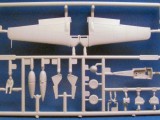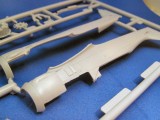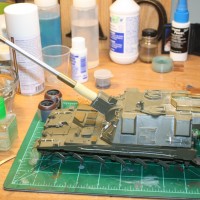iModeler Review: Airfix 1/72 Focke-Wulf Fw-190A-8
Airfix 1/72 Focke Wulf Fw190A-8 Product Code: A01020 49 gray parts 4 clear parts
First flying in 1939, the Focke-Wulf Fw190 proved to be an immediate threat to RAF fighters when introduced in late 1941, being faster and more maneuverable than the Spitfire V then in service. This A-8 version was the most numerous and heavily armed variant, which entered service in 1944, as an attempt to stop the Allied daylight raids, however, by then the new Allied fighters had begun to outclass it.
The kit comes in an end-opening box, and the sprues are sealed in a clear plastic bag. The clear parts are sealed in their own, small clear bag. The instructions are typical of Airfix, with the color callouts matched for Humbrol's new Luftwaffe range. As far as I know, however, this paint line is not yet available. Regardless, concessions can be easily made for your favorite RLM colors. But, still… The markings and painting guide is a four-view color affair on the back of the box. Decals seem to be in excellent register, and markings are for one machine; Black 11, Jagdgruppe 10, Pachim Airfield, Germany,1944. No swastika or “spiralschnauze” are included in the decals. You'll note that the markings guide shows the spiralschnauze present. Commission of these two key markings is a let-down.
As with almost all of their new releases, the panel lines are very restrained – dare I say, “fine”. The Hasegawa offering of the “-A8” has finer panel lines, but that kit is not without it's own issues. I like the direction that the Airfix kits are heading in. The grey plastic is rather soft, which I have come to expect from this manufacturer. Most, if not all parts have flash and/or heavy molding seams. In fact, the kit is reminiscent of a limited run Eastern European kit, not a mainstream manufacturer's product. This will make cleanup a chore. The sprue gates are still heavy and thick. This can be an issue for some of the more delicate parts.
The transparent parts are very clear, and options for an early style “flat “canopy or a late-war “blown” Erla style canopy are provided. The canopy can be positioned in the open or closed positions. One thing provided, that I haven't yet seen on the newer Airfix kits, is a gun sight molded in clear styrene. I think that this is a nice touch. The headrest armor and frame strike me as heavy and out of scale. The instrument panel has no detail, and will be provided for in the form of a decal. The cockpit tub has some raised detail, which will represent the side panels acceptably.
Compared to Karaya drawings, Airfix has made a very accurate representation of the FW-190A-8. However, they made a pretty obvious error – the inspection hatch on the port side of the rudder is also present on the starboard side (!). This is a simple fix to fill in and sand smooth, but leaves me scratching my head. The wings are a top-and-bottom assembly, with the top wings molded around the nicely detailed wheel well. The pitot tube is molded in place, making it vulnerable to handling damage. It also looks a bit heavy and thick. The wing's trailing edges are markedly thick. I'm not one who is in the habit of thinning trailing edges, but for this kit, I think it will be necessary. Additionally, the fabric patterns of the flying surfaces are overdone and heavy handed. Light sanding will improve this, but I'm surprised to see it to this degree.
The exhausts are molded in a manner of clever engineering - The side pipes are molded onto a bulkhead which gives the fuselage some rigidity. The lower pipes are molded on a flat plate. All pipes are visible behind the cooling vents after installation.
Two options are provided for the landing gear – extended, or “in flight'. The in-flight option has both gear doors molded as one piece, allowing for a simple fit. The extended option, however, is another issue that this kit suffers from. The main gear legs appear to be molded in the unloaded, fully-extended oleo link position. This will potentially cause the stance to be stork-like, or spindly. The gear legs are very fragile, so if the modeler decides to take out 2 or 3 millimeters to correct it, it may end up being more trouble than it's worth. The main wheels strike me as anemic at best. Resin aftermarket parts would benefit this project greatly.
Pros:
• Very accurate in outline.
• Price point is great.
• Canopy options.
• Landing gear options.
Cons:
• Very thick wing trailing edges.
• Exaggerated fabric effect on control surfaces
• Anemic main wheels.
• Landing gear is too long.
• Glaring omissions from decal sheet.
• Flash and heavy mold lines on most parts.
• Some parts seem “heavy” and out of scale.
• One marking option.
My sincere thanks to iModeler for the review sample.



























Nice to see Airfix attempting to update their VERY dated kits of the 60s. It's about time.
Thanks for a helpful review.
Keep'em comin'.
James! What do you think about it if you compare it to the Hasegawa kit? I know Hase is more expensive but if I'm not on a budget?
Regards
Magnus
Without pre-empting James' response. I still very much like the Hasegawa kit, which externally IMHO is briliantly executed both in terms of shapes, detail finesse and ease of assembly. It has two drawbacks though: bare cockpit (easy to fix with an aftermarket set) and very shallow wheel wells moulded integrally with the wing lower surface (NOT an easy fix). From what I can see, the Airfix kit shows potential in both areas.
Over to James' verdict...
Hi Magnus,
I guess it would all depend upon what you were looking for. The Hasegawa kit is still excellent after all these years. The panel lines are more refined, and there is a lot less work with regards to parts clean-up. However, it's 3x the price of the new Airfix release.(The 2-kit combo is around $50.00!) It's been re-released with a myriad of decal options, too.
While my review may seem like I'm a little disappointed with this new release (I am), the proof is in the build. I think that Airfix could have done a better job with this release, but I'm willing to bet that it's going to build up just fine. One thing I didn't mention in the review, is that the wheel wells will have a partially open area, which is, again, more accurate than what has been previously offered. There are plenty of aftermarket decals available to use with the Airfix kit, and resin wheels shouldn't be hard to find. If thats even an issue to the modeler. For an experienced builder, the Airfix kit is just fine...but, for a youngster, the clean up may be off-putting.
It`s a nice kit, I have got in my stash to build.
The new Airfix tooling is been long overdue, and with a large back catalogue we could see a long line of reasonably cheap kits on the market.
Nice review. I have one of this in my stash and had built the Hasegawa kit many moons ago.
In regards comparing the Hasegawa kit to this Airfix, in my opinion the Hasegawa is a GOOD kit, externally has the best details and overall finesse. However the interior is non-existent and the shallow wheel wells are annoying! It's more expensive and if you want to display a opened cockpit you will need to buy an aftermarket kit to be able to do so (or scratch built it). In the end you will spend the equivalent of 3 Airfix kits (or more, just being conservative). The Airfix represents a mid-term, you have a new engineered kit (could have done better with the panel lines), very decent interior details and overall good external details and most important, very good quality decals, especially if compared to Hasegawa ones.
Just my 5 Australian cents!